The Functional Literacy, Education, and Mass Media Survey (FLEMMS) is a household-based nationwide survey conducted every five years in accordance with the Designation of Statistical Activities that will Generate Critical Data for Decision-Making of the Government and the Private Sector (Executive Order No. 352 of 1996). The 2024 FLEMMS is the seventh in the series of literacy survey in the country since 1989. The survey operations for the 2024 FLEMMS was conducted from September 2024 to October 2024.
Among data collected through the 2024 FLEMMS were data to measure exposure of the population to different forms of mass media. Mass media refers to technology that is intended to reach a mass audience. It is the primary means of communication used to reach the vast majority of the general public.The most common platforms for mass media are newspapers, magazines, radio, television, and the internet.
Exposure Rate to Various Platforms
a. Reading Platforms
For mass media exposure to various reading platforms among individuals 10 to 64 years old in Northern Mindanao, exposure rate to printed magazine was recorded highest in 2024 at 51.3 percent, followed by printed poster at 50.1 percent while printed newspaper recorded lowest at 23.3 percent. Generally, exposure rate to reading platforms in printed forms dropped in 2024 compared to the data in 2019. This is expected with the exposure to other internet-based mass media platforms.
Online/digital newspaper was not covered in the 2019 FLEMMS but in the 2024 FLEMMS results, 41.7 percent of the population 10 to 64 years old in the region were exposed to digital newspaper (Figure 1).
Figure 1. Exposure Rate to Various Reading Platforms of Population 10 to 64 years old, Region X: 2019 and 2024 (in percent)*
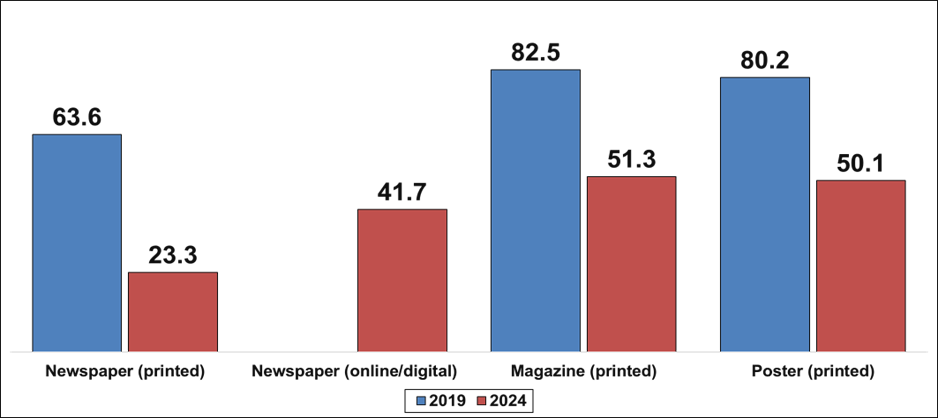
* A household may have more than one type of reading platform.
Source: Philippine Statistics Authority, 2024 Functional Literacy, Education and Mass Media Survey
b. Audio/Visual Platforms
Figure 2 shows exposure rate to various audio/visual platforms of individuals 10 to 64 years old in Region X which generally decreased in 2024. Exposure rate to television was recorded highest in 2024 at 78.3 percent, followed by watching movies, plays and other similar shows (57.8%), video streaming (57.5%), listening to radio (57.3%) while music streaming was recorded lowest at 53.5 percent.
The video and music streaming were not covered in the 2019 FLEMMS but for the 2024 FLEMMS, results showed that more than half of the population 10 to 64 years old in the region were exposed to this type of audio/visual platforms.
Figure 2. Exposure Rate to Various Audio/Visual Platforms of Population 10 to 64 years old, Region X: 2019 and 2024 (in percent)*
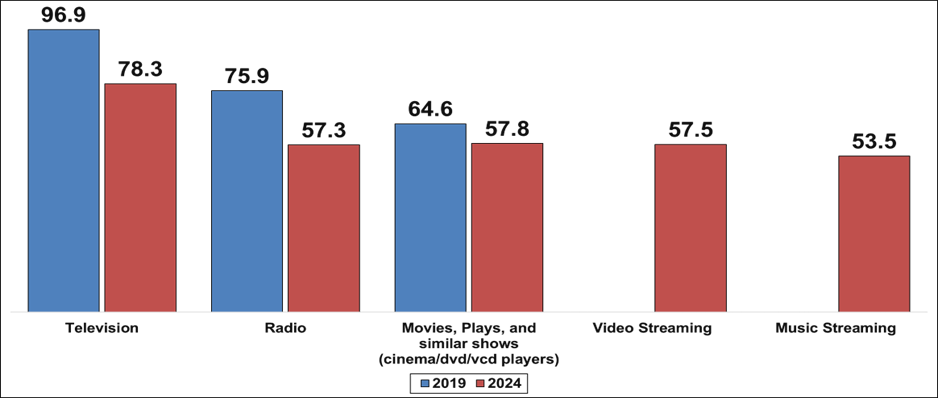
* A household may have more than one type of audio/visual platform.
Source: Philippine Statistics Authority, 2024 Functional Literacy, Education and Mass Media Survey
c. Internet Platforms
Exposure to digital medium of communication is measured through the frequency of surfing the internet for various purposes. For mass media exposure to various internet platforms, use of internet for work/research declined in 2024, while internet use for social media increased. Exposure rate for internet use to access social media recorded highest in 2024 at 73.6 percent or 7 out of 10 persons aged 10 to 64 years old in Northern Mindanao were using the internet to browse or access the different social media platforms.
Furthermore, usage of internet for e-commerce platform such as online buying and selling was at 37.1 percent, and usage of internet for availing government services, accessing financial transactions, and online banking was at 29.7 percent.
Note that, internet use for e-commerce and for availing government services, financial transactions, and online banking were not covered in the 2019 FLEMMS (Figure 3).
Figure 3. Usage Rate of Internet Platforms by Type of Usage of Population 10 to 64 years old, Region X: 2019 and 2024 (in percent)*
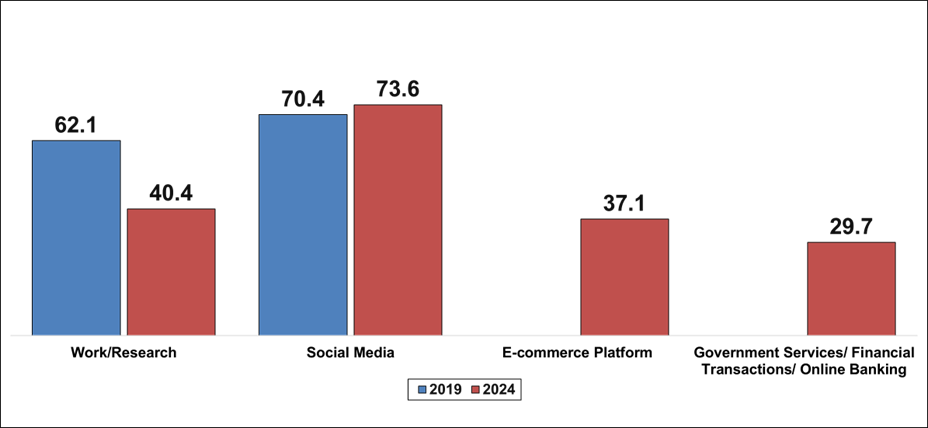
* A household may have more than one type of internet platform.
Source: Philippine Statistics Authority, 2024 Functional Literacy, Education and Mass Media Survey
II. Ownership of Information and Communication (ICT) Devices
Results of the 2024 FLEMMS showed that in 2024, 82.8 percent of Filipino households in Region X owned cellular phones while 57.2 percent owned television. The proportion of households that owned television, however, declined by 17.9 percentage points while those that owned radio declined by 10.5 percentage points compared to 2019 data.
Figure 4. Proportion of Households that Own ICT Devices, Region X, 2019 and 2024 (in percent)*
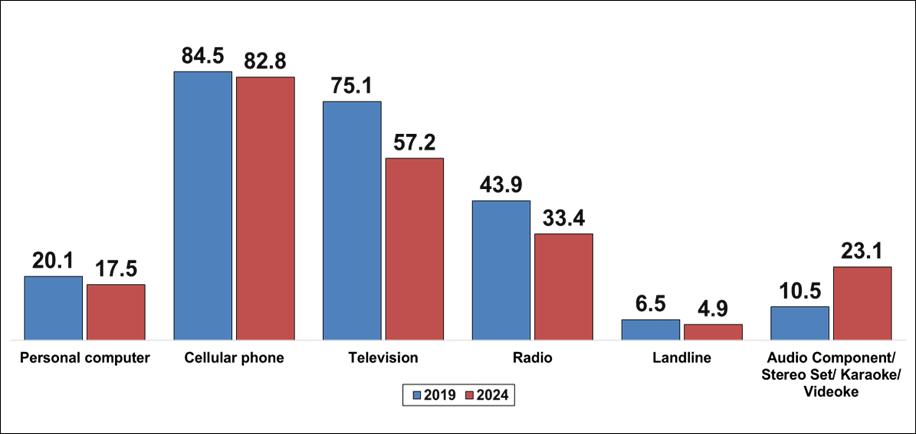
* A household may have more than one type of ICT devices.
Source: Philippine Statistics Authority, 2024 Functional Literacy, Education and Mass Media Survey
III. Household Subscription
Table 1. Proportion of Households with Subscription, Region X: 2019 and 2024 (in percent) *
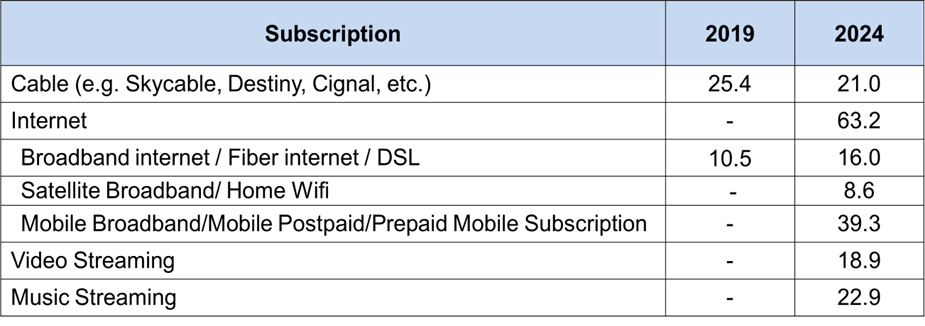
* A household may have more than one type of ICT devices.
** In 2019, personal computer includes desktop, laptop, netbook, iPad, iPod, tablet while in 2024, tablet is separated into a different category.
Note: Satellite broadband/home wifi, mobile subscriptions, video and music streaming were not covered in the 2019 FLEMMS.
Source: Philippine Statistics Authority, 2024 Functional Literacy, Education and Mass Media Survey.
For household subscriptions, 39.3 percent of the households subscribed to mobile broadband, mobile postpaid plans, and prepaid mobile subscription in 2024. Additionally, the proportion of households with cable subscriptions was at 21.0 percent, a decreased by 4.4 percentage points from 2019. Conversely, subscription to
broadband internet/fiber internet/DSL increased by 5.5 percentage points from 2019 to 2024.
Note that satellite broadband/home Wi-Fi, mobile subscriptions, video and music streaming were not covered in the 2019 FLEMMS.
(SGD.)JANITH C. AVES, CE, DM
Regional Director
PSA-RSSO X

